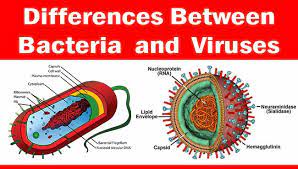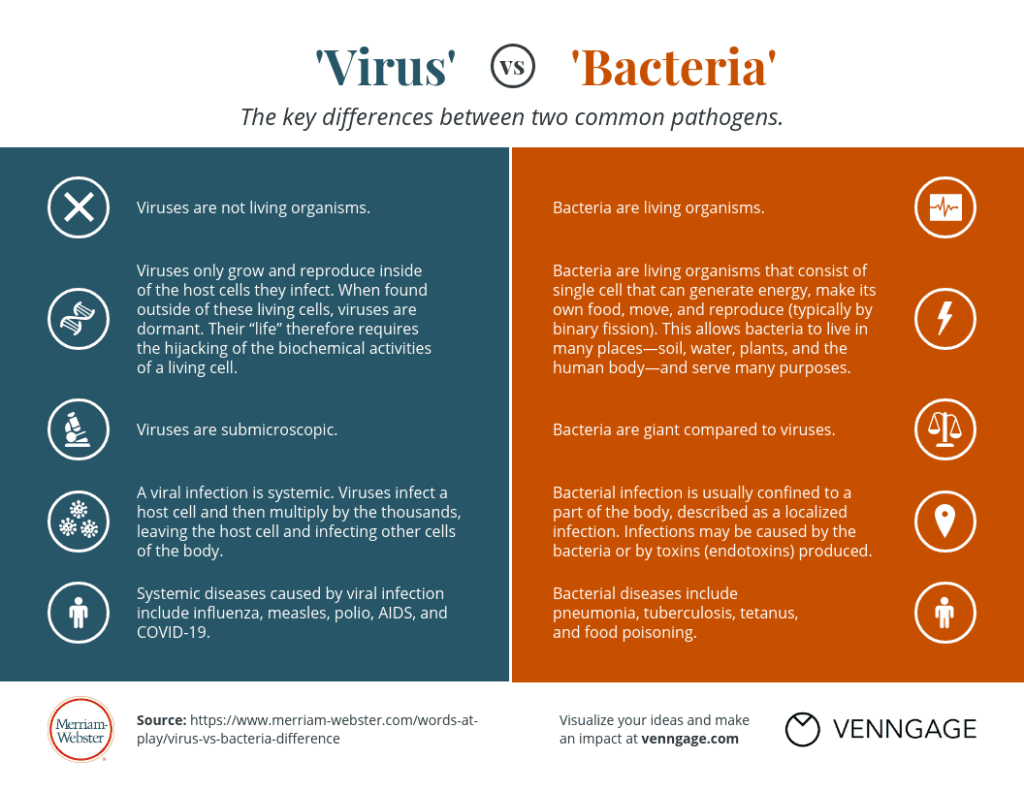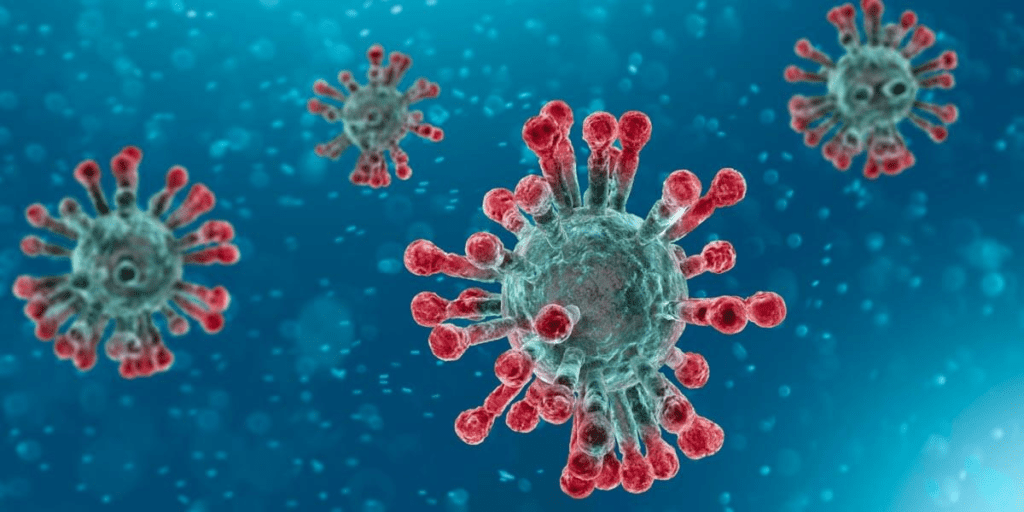How are viruses different from bacteria apex?


How are viruses different from bacteria Apex: Bacteria are all unicellular microbes, whereas viruses are non-cellular. They are invisible to the human eye. The sizes of all viruses range from 250 nanometers (nm) to 20 nanometers (nm).
Viruses are tens to thousands of times smaller than bacteria. All viruses lack a cell wall, whereas bacteria do. Bacteria may exist both within and outside the body, whereas viruses are non-living and require a host to survive.
The structures of all bacteria and viruses differ. Bacterial cell walls contain peptidoglycan, but viruses lack a cell wall. Ribosomes are found in bacterial cells but are lacking in viruses.
Bacteria reproduce through binary fission, whereas viruses reproduce through lytic fission. Less than 1% of bacteria cause disease, but the majority of viruses do.
READ ALSO: Madonna Hospitalized with Bacterial infection
Antibiotics are used to treat bacteria, whereas vaccinations are used to cure viruses. All bacteria and viruses spread in similar ways, such as mother-to-child transmission at birth, contact with an infectious person, close contact with an infectious surface, and close contact with infectious body fluid through kissing, intercourse, and urine.
Bacteria and viruses, in particular, can cause both mild and severe disorders.


What are bacterias?


Bacteria can be found on the land, in the air, in the forest, in plants, in humans, and in animals. Prokaryotes are all bacteria, and the majority of bacteria have cell walls. Bacteria are unicellular, although some are multicellular.
Bacteria have been around for at least 3.5 billion years. There are 10 billion times more bacteria in the ocean than stars in the universe. Bacteria cannot be seen with the naked eye. To observe microbes, we need a microscope.
Saprophytic bacteria are all bacteria that receive their sustenance from dead organic materials. And heterotrophic bacteria are those that cannot manufacture organic food from inorganic food.
A cell membrane, cytoplasm, ribosomes, and chromatin bodies are found in all bacterial cells. Bacterial cells, in general, have a cell wall that gives them form.
Bacteria are commonly employed in chemical industries, product manufacturing, and pharmaceutical production. Dangerous bacteria can also be found in soil.
Bacteria are divided into three types based on their shape: cocci, bacilli, and spiral. In the body, cocci are spherical or oval microorganisms. Bacilli are bacteria that are rod-shaped.
Spirals are bacteria that are spirally coiled in the body. Spirals are also classified into three types: Vibro, spirillum, and spirochete. Only a small percentage of microorganisms can cause disease.
There are two types of Gram-negative and Gram-positive bacteria:
Gram-positive bacteria have only one major layer. There is a 20-80 nm overall thickness. There are 1-4% lipids. There is no outer membrane and there is also periplasmic space present in some. Gram-positive bacteria are more permeable.
Gram-negative bacteria have two major layers. There is only an 8-11 nm overall thickness. There are 11-12% lipids. There is an outer membrane and there is periplasmic space present in all. Gram-negative bacteria are less permeable.
What are viruses?


The term virus comes from the Latin word venom, which implies dangerous fluid. All viruses are exceedingly tiny and can only be seen with an electron microscope. Viruses are non-cellular infectious agents that include RNA and DNA.
Viruses can be found in the form of virions. Viruses are far smaller than bacteria. All viruses cannot replicate on their own.
All viruses fail to carry out metabolic functions. To make copies, they take components from a host cell. All viruses are unable to multiply and divide.
All viruses are spread from one body to another. Many human diseases are caused by viruses, including covid 19, AIDs, measles, dengue fever, flu, HIV, rabies, pneumonia, common cold, and smallpox.
Viruses also cause the most prevalent diseases, such as hepatitis and influenza.
Viruses include the vaccinia virus, tubulovirus, herpesvirus, orf virus, T-even coliphage virus, polyomavirus, and influenza virus, among others.
All viruses propagate in a variety of ways, such as influenza, which spreads in humans through the air. The dengue virus is carried by blood-sucking insects. Furthermore, several infections, such as HIV, AIDS, and Hepatitis B, are transferred during intercourse.
Viruses transmit through vectors in animals and plants. “Benign” viruses are those that produce little or no sickness. Viruses primarily assault the respiratory tract, liver, and blood.
An electron microscope produced the first image of the virus in 1931, and an American scientist and virologist named Wendell Meredith Stanly discovered the viral tobacco mosaic virus in 1935.
Genes of viruses are made by either RNA and DNA. The main viruses have RNA. Viruses either contain double or single-strand helix. In some viruses, the gene is separated like influenza have eight separate genes.
FAQs:
What are the major 3 differences between bacteria and viruses?
All viruses are 10 to 1000 times smaller than all bacteria. All bacteria reproduce by binary fission while all viruses reproduce by lytic fission. All bacteria can survive without any host but viruses can not survive without any host.
What is the full form of the virus and who discovered it?
The full form of the virus is vital information resources under siege and Beijerinck, in 1898 was the first to call the virus.
What are the bacteria?
All Bacteria are classified as prokaryotic organisms. They are all single-celled organisms. They live in soil, forest, water, plants, animals, and other living and non-living things.
What is the main function of the bacteria?
All bacteria help our bodies degrade the food we eat, make nutrients available to us and neutralize toxins. Bacteria are also used in making products, and drugs, and killing plant pests.
What is the difference between bacteria and viruses in terms of treatment?
Bacteria cause bacterial infection while viruses cause viral diseases. We use antibiotics for the treatment of bacterial infection while vaccines are used for the treatment of viral diseases.
List the top six diseases caused by viruses.
Smallpox, HIV, AIDs, Influenza, Measles, and Polio are the main diseases caused by viruses.
List the top five diseases caused by bacteria.
Tuberculosis, E.coli, whooping cough, salmonella, and strep throat are the main diseases caused by bacteria.
Bacteria are unicellular microorganisms that can be found everywhere in the environment. Viruses are microorganisms that can only reproduce within the cells of a host organism.
The differences between viruses and bacteria include;
- Viruses do not have any cells and are considered between living and non-living things, while bacteria have one cell (Unicellular) and are living organisms.
- Viruses are smaller in size (20-400 nm) when compared with bacteria (1000 nm).
- Viruses do not have a cell wall but a protein coat is present, while bacteria have a cell wall that is composed of peptidoglycan.
- Viruses require a living cell to reproduce, while bacteria can reproduce by themselves.
- The DNA or RNA of viruses is enclosed inside a coat of protein, while that of bacteria floats freely in the cytoplasm within the cell.




